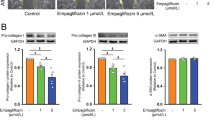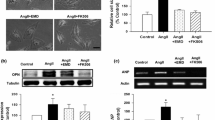Abstract
Purpose
We assessed whether the SGLT-2 inhibitor dapagliflozin (Dapa) attenuates the upregulation of the cardiac Na+/H+ exchanger (NHE-1) in vitro in mouse cardiofibroblasts stimulated with lipopolysaccharides (LPS) and whether this effect is dependent on adenosine monophosphate kinase (AMPK) activation.
Methods
Mouse cardiofibroblasts were exposed for 16 h to Dapa (0.4 μM), AMPK activator (A769662 (10 μM)), AMPK inhibitor (compound C (CC) (10 μM)), an SGLT-1 and SGLT-2 inhibitor (phlorizin (PZ) (100 μM)), Dapa+CC, or Dapa+PZ, and then stimulated with LPS (10 ng/ml) for 3 h. NHE-1 mRNA levels were assessed by rt-PCR and total AMPK, phosphorylated-AMPK (P-AMPK), NHE-1, and heat shock protein-70 (Hsp70) protein levels in the whole cell lysate by immunoblotting. In addition, NHE-1 protein levels attached to Hsp70 were assessed by immunoprecipitation.
Results
Exposure to LPS significantly reduced P-AMPK levels in the cardiofibroblasts. A769662 and Dapa equally increased P-AMPK. The effect was blocked by CC. Phlorizin had no effect on P-AMPK. LPS exposure significantly increased NHE-1 mRNA levels. Both Dapa and A769662 equally attenuated this increase. The effect of Dapa was blocked with CC. Interestingly, none of the compounds significantly affected NHE-1 and Hsp70 protein levels in the whole cell lysate. However, LPS significantly increased the concentration of NHE-1 attached to Hsp70. Both Dapa and A69662 attenuated this association and CC blocked the effect of Dapa. Again, phlorizin had no effect and did not alter the effect of Dapa.
Conclusions
Dapa increases P-AMPK in cardiofibroblasts exposed to LPS. Dapa attenuated the increase in NHE-1 mRNA and the association between NHE-1 and Hsp70. This effect was dependent on AMPK.



Similar content being viewed by others
References
Zinman B, Wanner C, Lachin JM, Fitchett D, Bluhmki E, Hantel S, et al. Empagliflozin, cardiovascular outcomes, and mortality in type 2 diabetes. N Engl J Med. 2015;373(22):2117–28.
Neal B, Perkovic V, Mahaffey KW, de Zeeuw D, Fulcher G, Erondu N, et al. Canagliflozin and cardiovascular and renal events in type 2 diabetes. N Engl J Med. 2017;377(7):644–57.
Udell JA, Yuan Z, Rush T, Sicignano NM, Galitz M, Rosenthal N. Cardiovascular outcomes and risks after initiation of a sodium glucose cotransporter 2 inhibitor: results from the EASEL population-based cohort study (evidence for cardiovascular outcomes with sodium glucose cotransporter 2 inhibitors in the real world). Circulation. 2018;137(14):1450–9.
Birkeland KI, Jorgensen ME, Carstensen B, Persson F, Gulseth HL, Thuresson M, et al. Cardiovascular mortality and morbidity in patients with type 2 diabetes following initiation of sodium-glucose co-transporter-2 inhibitors versus other glucose-lowering drugs (CVD-REAL Nordic): a multinational observational analysis. Lancet Diabetes Endocrinol. 2017;5(9):709–17.
Kosiborod M, Lam CSP, Kohsaka S, Kim DJ, Karasik A, Shaw J, et al. Cardiovascular events associated with SGLT-2 inhibitors versus other glucose-lowering drugs: the CVD-REAL 2 study. J Am Coll Cardiol. 2018;71(23):2628–39.
Baartscheer A, Schumacher CA, Wust RC, Fiolet JW, Stienen GJ, Coronel R, et al. Empagliflozin decreases myocardial cytoplasmic Na(+) through inhibition of the cardiac Na(+)/H(+) exchanger in rats and rabbits. Diabetologia. 2017;60(3):568–73.
Uthman L, Baartscheer A, Bleijlevens B, Schumacher CA, Fiolet JWT, Koeman A, et al. Class effects of SGLT2 inhibitors in mouse cardiomyocytes and hearts: inhibition of Na(+)/H(+) exchanger, lowering of cytosolic Na(+) and vasodilation. Diabetologia. 2018;61(3):722–6.
Kohlhaas M, Maack C. Adverse bioenergetic consequences of Na+-Ca2+ exchanger-mediated Ca2+ influx in cardiac myocytes. Circulation. 2010;122(22):2273–80.
Bertero E, Prates Roma L, Ameri P, Maack C. Cardiac effects of SGLT2 inhibitors: the sodium hypothesis. Cardiovasc Res. 2018;114(1):12–8.
Kohlhaas M, Liu T, Knopp A, Zeller T, Ong MF, Bohm M, et al. Elevated cytosolic Na+ increases mitochondrial formation of reactive oxygen species in failing cardiac myocytes. Circulation. 2010;121(14):1606–13.
Lang F, Foller M. Regulation of ion channels and transporters by AMP-activated kinase (AMPK). Channels (Austin). 2014;8(1):20–8.
Ye Y, Bajaj M, Yang HC, Perez-Polo JR, Birnbaum Y. SGLT-2 inhibition with dapagliflozin reduces the activation of the Nlrp3/ASC inflammasome and attenuates the development of diabetic cardiomyopathy in mice with type 2 diabetes. Further augmentation of the effects with saxagliptin, a DPP4 inhibitor. Cardiovasc Drugs Ther. 2017;31(2):119–32.
Kanwal A, Nizami HL, Mallapudi S, Putcha UK, Mohan GK, Banerjee SK. Inhibition of SGLT1 abrogates preconditioning-induced cardioprotection against ischemia-reperfusion injury. Biochem Biophys Res Commun. 2016;472(2):392–8.
Kashiwagi Y, Nagoshi T, Yoshino T, Tanaka TD, Ito K, Harada T, et al. Expression of SGLT1 in human hearts and impairment of cardiac glucose uptake by phlorizin during ischemia-reperfusion injury in mice. PLoS One. 2015;10(6):e0130605.
Tirmenstein M, Dorr TE, Janovitz EB, Hagan D, Abell LM, Onorato JM, et al. Nonclinical toxicology assessments support the chronic safety of dapagliflozin, a first-in-class sodium-glucose cotransporter 2 inhibitor. Int J Toxicol. 2013;32(5):336–50.
Beloto-Silva O, Machado UF, Oliveira-Souza M. Glucose-induced regulation of NHEs activity and SGLTs expression involves the PKA signaling pathway. J Membr Biol. 2011;239(3):157–65.
Huang C, Wang J, Chen Z, Wang Y, Zhang W. 2-phenylethynesulfonamide prevents induction of pro-inflammatory factors and attenuates LPS-induced liver injury by targeting NHE1-Hsp70 complex in mice. PLoS One. 2013;8(6):e67582.
Xue J, Zhou D, Yao H, Gavrialov O, McConnell MJ, Gelb BD, et al. Novel functional interaction between Na+/H+ exchanger 1 and tyrosine phosphatase SHP-2. Am J Physiol Regul Integr Comp Physiol. 2007;292(6):R2406–16.
da Costa-Pessoa JM, Damasceno RS, Machado UF, Beloto-Silva O, Oliveira-Souza M. High glucose concentration stimulates NHE-1 activity in distal nephron cells: the role of the Mek/Erk1/2/p90RSK and p38MAPK signaling pathways. Cell Physiol Biochem. 2014;33(2):333–43.
Dreffs A, Henderson D, Dmitriev AV, Antonetti DA, Linsenmeier RA. Retinal pH and acid regulation during metabolic acidosis. Curr Eye Res. 2018;43(7):902–12.
Javadov S, Rajapurohitam V, Kilic A, Zeidan A, Choi A, Karmazyn M. Anti-hypertrophic effect of NHE-1 inhibition involves GSK-3beta-dependent attenuation of mitochondrial dysfunction. J Mol Cell Cardiol. 2009;46(6):998–1007.
Rotte A, Pasham V, Eichenmuller M, Bhandaru M, Foller M, Lang F. Upregulation of Na+/H+ exchanger by the AMP-activated protein kinase. Biochem Biophys Res Commun. 2010;398(4):677–82.
Hardie DG. AMPK--sensing energy while talking to other signaling pathways. Cell Metab. 2014;20(6):939–52.
Hardie DG. AMPK: positive and negative regulation, and its role in whole-body energy homeostasis. Curr Opin Cell Biol. 2015;33:1–7.
Lin SC, Hardie DG. AMPK: sensing glucose as well as cellular energy status. Cell Metab. 2018;27(2):299–313.
Wang L, Quan N, Sun W, Chen X, Cates C, Rousselle T, et al. Cardiomyocyte specific deletion of Sirt1 gene sensitizes myocardium to ischemia and reperfusion injury. Cardiovasc Res. 2018;114:805–21.
Chang YK, Choi H, Jeong JY, Na KR, Lee KW, Lim BJ, et al. Dapagliflozin, SGLT2 inhibitor, attenuates renal ischemia-reperfusion injury. PLoS One. 2016;11(7):e0158810.
Hawley SA, Ford RJ, Smith BK, Gowans GJ, Mancini SJ, Pitt RD, et al. The Na+/glucose cotransporter inhibitor canagliflozin activates AMPK by inhibiting mitochondrial function and increasing cellular AMP levels. Diabetes. 2016;65(9):2784–94.
Hannan KM, Little PJ. Mechanisms regulating the vascular smooth muscle Na/H exchanger (NHE-1) in diabetes. Biochem Cell Biol. 1998;76(5):751–9.
Takahashi E, Abe J, Gallis B, Aebersold R, Spring DJ, Krebs EG, et al. p90(RSK) is a serum-stimulated Na+/H+ exchanger isoform-1 kinase. Regulatory phosphorylation of serine 703 of Na+/H+ exchanger isoform-1. J Biol Chem. 1999;274(29):20206–14.
Chistiakov DA, Orekhov AN, Bobryshev YV. The role of cardiac fibroblasts in post-myocardial heart tissue repair. Exp Mol Pathol. 2016;101(2):231–40.
Pernicova I, Korbonits M. Metformin--mode of action and clinical implications for diabetes and cancer. Nat Rev Endocrinol. 2014;10(3):143–56.
American Diabetes A. 8. Pharmacologic approaches to glycemic treatment: standards of medical care in diabetes-2018. Diabetes Care. 2018;41(Suppl 1):S73–85.
Funding
The study was funded by the John S. Dunn Chair in Cardiology Research and Education.
Author information
Authors and Affiliations
Corresponding author
Ethics declarations
Conflict of Interest
Dr. Ye received research grants from Astra Zeneca and Boehringer Ingelheim. Dr. Bajaj received research grants from AstraZeneca, Boehringer Ingelheim, Eli-Lilly, Sanofi Aventis, and Novo Nordisk. Dr. Birnbaum receives research grants from Astra Zeneca. Dr. Jia has no conflict of interest.
Research Involving Animals
Mice received humane care in compliance with The Guide for the Care and Use of Laboratory Animals published by the National Institutes of Health (NIH Publication No. 85–23, revised 1996). The protocol was approved by the University of Texas Medical Branch IACUC, Galveston, Texas, USA.
Rights and permissions
About this article
Cite this article
Ye, Y., Jia, X., Bajaj, M. et al. Dapagliflozin Attenuates Na+/H+ Exchanger-1 in Cardiofibroblasts via AMPK Activation. Cardiovasc Drugs Ther 32, 553–558 (2018). https://doi.org/10.1007/s10557-018-6837-3
Published:
Issue Date:
DOI: https://doi.org/10.1007/s10557-018-6837-3




